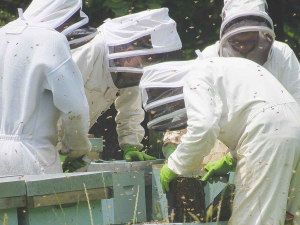Damien O’Connor: NZ united on global trade
When it comes to international trade, politicians from all sides of the aisle are united, says Labour's trade spokesman Damien O'Connor.
 Kiwi mānuka honey sales to the EU have risen dramatically in recent years reaching $60 million last year.
Kiwi mānuka honey sales to the EU have risen dramatically in recent years reaching $60 million last year.
The impact of a new European Union free trade agreement removing a 17.3% tariff on NZ-sourced honey in July is translating into increasing sales volumes, according to one exporter.
Aided by strong harvest volumes, mānuka honey exporters have recorded a surge in European demand as the removal of tariffs aligns with a sliding NZ dollar, reducing the cost of Kiwi imports by around 8% against the Euro compared to the same time last year.
Driven by growing interest from German consumers for Kiwi mānuka honey, sales to the EU have risen dramatically in recent years reaching $60 million last year, or 12% of the $500m export market.
Industry experts say the 2023 season is expected to be strong, with high moisture levels at the base of the mānuka trees and La Nina weather patterns set to contribute to elevated nectar flows over the coming months.
Additionally, a 40% drop in hive numbers around the country is providing more choice of placement locations for Kiwi apiarists and a higher quality export product.
“Too many beehives placed in these areas targeting mānuka overstocked the area because there’s only so much nectar, [with] yields per hive decreasing by a considerable amount,” says Naki Honey executive Brett Mascull.
“Because of the lesser amount of beehives, you can expect really strong yields per beehive for mānuka honey.”
Naki Honey global market manager Derek Burchell-Burger says the response from the EU importers following the removal of import tariffs was immediate, contributing to an annual sales growth of over 15%.
“Despite consumer confidence being impacted by the war in Ukraine the pandemic has helped boost consumer interest in the wellness features of the product, with premium mānuka honey retailing for up to $800 per kg in Europe and landing in Europe for 27% less cost than a year ago.”
He says there is growing international recognition of the benefits of mānuka honey and harvest volumes are up substantially.
This has allowed us to increase our inventory to over 300 tonnes.”
Burchell-Burger adds that the falling dollar is helping to secure new wholesale accounts throughout the EU, offsetting the impact of war and inflation on spending in that market and resulting in exports growing.
Naki Honey’s distribution model in European markets operates differently to those in Asia where they tend to use established distribution partners with local networks.
In EU countries like Germany and Sweden the product is more likely to be sold through pharmacies, supermarkets and naturopathic practitioners necessitating the development of relationships at retail level.
“Even prior to the pandemic, European consumers had a high awareness of the medicinal aspects of mānuka honey,” says Burchell- Burger.
While Germany is the largest EU importer of honey from non-EU countries and second largest honey importer worldwide, France is second in the EU (fifth worldwide) with almost $1bn of the product consumed annually.
Naki Honey is currently looking to France as the next untapped market for mānuka honey. Sales to other European countries including Germany, The Czech Republic, and The Netherlands have also expanded recently.
Legal controls on the movement of fruits and vegetables are now in place in Auckland’s Mt Roskill suburb, says Biosecurity New Zealand Commissioner North Mike Inglis.
Arable growers worried that some weeds in their crops may have developed herbicide resistance can now get the suspected plants tested for free.
Fruit growers and exporters are worried following the discovery of a male Queensland fruit fly in Auckland this week.
Dairy prices have jumped in the overnight Global Dairy Trade (GDT) auction, breaking a five-month negative streak.
Alliance Group chief executive Willie Wiese is leaving the company after three years in the role.
A booklet produced in 2025 by the Rotoiti 15 trust, Department of Conservation and Scion – now part of the Bioeconomy Science Institute – aims to help people identify insect pests and diseases.

OPINION: The release of the Natural Environment Bill and Planning Bill to replace the Resource Management Act is a red-letter day…
OPINION: Federated Farmers has launched a new campaign, swapping ‘The Twelve Days of Christmas’ for ‘The Twelve Pests of Christmas’ to…